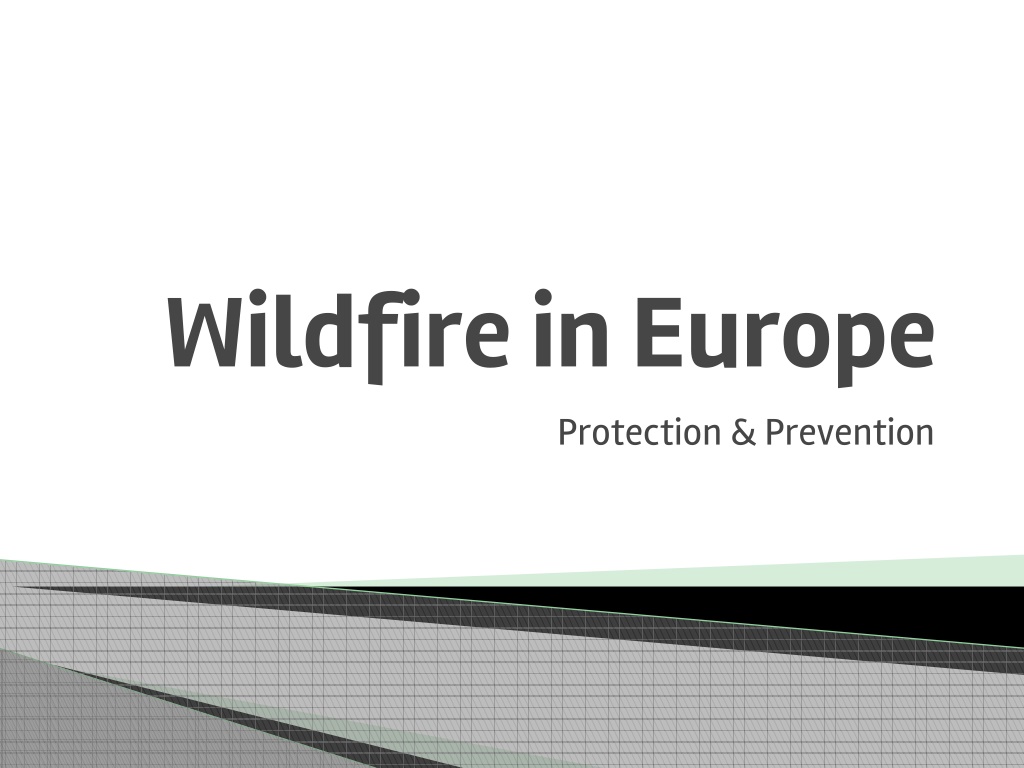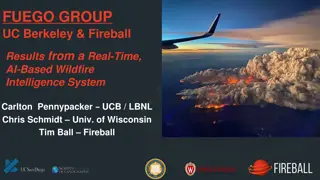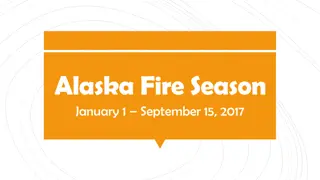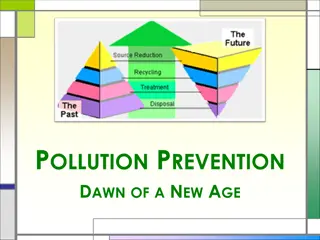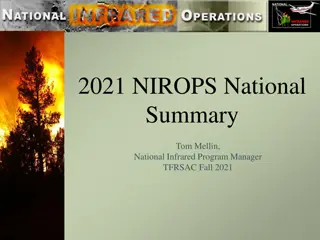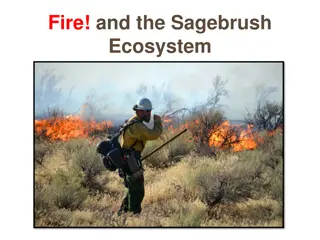Wildfires in Europe: Protection and Prevention
Our environment is constantly evolving, and with it comes the pressing need to address environmental challenges like wildfires. In Europe, wildfires pose a significant threat, with a high number of incidents reported annually. This article delves into the impact of wildfires, the extent of forested areas in Europe, and the key factors contributing to the occurrence of wildfires. By gaining a deeper understanding of these issues, we can work towards better protection and prevention strategies to safeguard our natural landscapes.
Uploaded on Sep 09, 2024 | 1 Views
Download Presentation

Please find below an Image/Link to download the presentation.
The content on the website is provided AS IS for your information and personal use only. It may not be sold, licensed, or shared on other websites without obtaining consent from the author.If you encounter any issues during the download, it is possible that the publisher has removed the file from their server.
You are allowed to download the files provided on this website for personal or commercial use, subject to the condition that they are used lawfully. All files are the property of their respective owners.
The content on the website is provided AS IS for your information and personal use only. It may not be sold, licensed, or shared on other websites without obtaining consent from the author.
E N D
Presentation Transcript
Wildfire in Europe Protection & Prevention
The worldwide problem Our environment is constantly changing. There is no denying that. However, as our environment changes, so does the need to become increasingly aware of the problems that surround it. With a massive influx of natural disasters, warming and cooling periods, different types of weather patterns and much more, people need to be aware of what types of environmental problems our planet is facing. One of this problems are wildfires.
The definition of the forest A forest is a large area dominated by trees. Forests are the dominant terrestrial ecosystem of Earth, and are distributed across the globe. Forests can be classified in different ways and to different degrees of specificity. One such way is in terms of the biome in which they exist, combined with leaf longevity of the dominant species: Deciduous forest Coniferous forest Laurel forest Boreal forest Tropical and subtropical moist broadleaf forests
Surface of forests in Europe There are 1,600,000 km2 of forested area in Europe. That s 35.00% of land area. Compared with other continents, it ranks Europe at 6th place in the ranking comparing the size of wooded land. Polar regions (Russia, Scandinavia and North America) are at the first places, while Latin America and the Caribbean are next. Comparing the nations on the background of the whole world, Sweden ranks 24th and France at 26th place. Other countries of Europe: Finland, 28th place, 72,00% Spain, 36th place, 36,70% Norway, 46th place, 37,42%
Wildfire in Europe 790 wildfires were reported in Europe, in the period between April 1 and October 12, 2016, according to the European Firenews service. Several countries, such as Italy or France, suffered major fires that caused massive devastation of the green surface while others were mostly only affected by small and medium fires. 215 and 119 wildfires were observed in France and Italy alone. Fuel, an oxidizing agent, and sufficient heat are needed to start a wildfire. In the forest area, fuel is an abundant parameter, along with oxygen, which acts as the oxidizing agent. During drought periods the barks of the trees are more flammable while the underground can completely dry out. Strong winds or even light breezes can expedite the development of a wildfire.
List of wildfires in Europe 2000 fires in Southern Europe in July 2000 consumed forests and buildings in southern France, parts of Iberia, Corsica, and most of Italy including the southern part during the heatwave dominating southern Europe with 40 to 45 C temperatures caused the phenomena. 2009 Mediterranean wildfires in France, Greece, Italy, Spain, and Turkey in July 2009 Ku nia Raciborska fire in Poland burned 90.62 km of forest and killed two firefighters on 26 August 1992. A third casualty is often mentioned, but she did not die in the fire; she was involved in a collision with a fire engine that skidded. August 2003 Wildfires, destroying 10% of Portuguese forests and killing 18 people August 2014 V stmanland province, Sweden, a 191 km2forest fire with 1 verified death. May 2011 Swinley Forest fire, Berkshire, England. Fire appliances from 12 counties attended over several days due to the large area of the fire. The fire service incident log for the call is over 500 pages long. 2005 East Attica Fire in Greece Forest fires ravaged East Attica on 28 July 2005 from Agia Triada Rafinas to west of Rafina. The fires began at around 11:00 consuming 70 square kilometers of forests, properties and farmlands. The fire spread quickly after a few hours with winds of up to 55 to 70 km/h and spread near the suburban housings of Athens near Rafina causing dense smoke. The fire reached Kallitechnio and the settlements by around 3:30 (EET) and devastated homes leaving some people homeless and evacuated people in areas around Agia Triada Rafinas, Agia Kyriaki Rafinas, Kallitechnio, Loutsa, Neos Vourtzas and the Rafina area mostly on the hillside areas. Pine trees were devastated. Firefighters didn't put out the blaze until the winds calmed down around 5:00 (EET). It took hundreds of fire trucks, firefighters, planes, 65 firefighting helicopters from all over the surrounding areas and most of Greece to put out the blaze. A stretch of Marathonos Avenue became closed. 29 July 2005 a day after the enormous Attica fire, another series of fires occurred throughout Greece, entirely in Preveza including Monolithi consuming properties and a campground, Ioannina and Xiromeni of Aetolia-Acarnania. 2000 forest fires in Greece, a series of forest fires affected Greece including Agioi Theodoroi and eastern Corinthia at the beginning of July 2000
Reasons of wildfires Wrong using of pyrotechnic materials Making fires in the forests Natural causes like sunlight Arson Defects of devices and installations Lightning discharge
Biaowiea Forest Is one of the last and largest remaining parts of the immense primeval forest that once stretched across the European Plain. The entire area of northeastern Europe was originally covered by ancient woodland similar to that of the Bia owie a Forest. On the Polish side, part of the Bia owie a Forest is protected as the Bia owie a National Park (Polish: Bia owieski Park Narodowy), with an area of about 105 km2(41 sq mi). There is also the Bia owie a Glade (Polish: Polana Bia owieska), with a complex of buildings once owned by the tsars of Russia during the Partitions of Poland.
Wildfire near Racibrz forest (August 1992) Forest fire in the Rudy Racib rz forest district - the largest wildfire in Poland and Central and Western Europe after the Second World War. It started on 26th of August 1992 at about 13.50 and was later noticed in branch 109 (near railway line connecting Racib rz with K dzierzyn-Ko le) Kiczowa forestry, Rudy Raciborskie forest near Solarnia.
Its easy to start fire but... Effects of the fires : During fire the forest separating a toxically reeks which working negative on the environment. After fire the forest-natural lubf earth regenerating for decades. Often enough spar to burned down a few, over dozen or several dozen hectares forest. People account for over 90% of forest fires.
What to do when we notice a fire in the woods ? Notify of the that situation the fire brigade. Assess situation if a small area is burning, try to extinguish it, use a : feather, blanket , shovel If it is a fire impossible to extinguish by you, make sure you are in a safe place. If you aren t run away ! If you find yourself in the smoke zone. Lean low and cover your mouth and nose. If it possible go to the road to the forest and wait for a fire-brigade or forestry service and show them the location of the fire.
Sources of our presentation http://www.edukacja.psp.wlkp.pl/index.php?option=com_content&view=article &id=110%3Apoary-lasow&catid=45%3Abezpiecznie-w-lesie-i-na- wsi&Itemid=105 https://en.wikipedia.org/wiki/Forest https://en.wikipedia.org/wiki/List_of_countries_by_forest_area https://watchers.news/2016/10/19/wildfires-in-europe-sentinel-2016/ http://www.straz.gov.pl/porady/pozary_lasow https://pl.wikipedia.org/wiki/Po%C5%BCar_lasu_ko%C5%82o_Ku%C5%BAni_Ra ciborskiej_(sierpie%C5%84_1992) https://en.wikipedia.org/wiki/Bia%C5%82owie%C5%BCa_Forest
About us Dominika Filip, ZSP nr 5 w Kro nie, klasa 1 fl Magdalena Rymarowicz, ZSP nr 5 w Kro nie, klasa 1 fl Jagoda Guzek, ZSP nr 5 w Kro nie, klasa 1 fl
